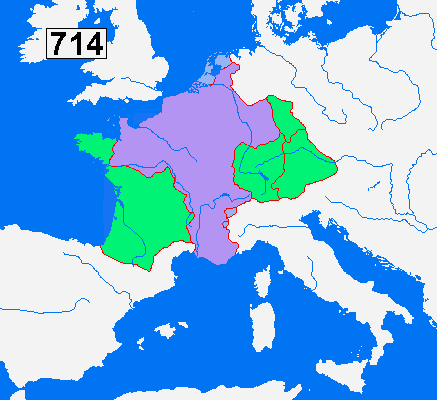Something has been bothering me for some time because of the lack of detailed Y-DNA data in the Balkans. There is an unusually high percentage of typically Germanic haplogroups (I1, I2b, R1b and R1a) in Macedonia, Albania, Montenegro, Serbia, and to a lower extent Bosnia-Herzegovina. The combined studies I used to create the table of Y-DNA frequencies totalled an amazing 10% of I1 in Macedonia and 4% of I2b in Serbia. The Pericic et al. study of the Balkans found 5% of I1 among Herzegovinians, Serbs, Kosovar Albanians and Macedonians.
If only I could get a detailed analysis of R1b subclades and R1a STR markers in that region, I would be able to confirm whether the four haplogroups came together as part of a major Germanic migration. The only one I can think of are the Visigoths in the late 4th century. They started their invasion of the Roman Empire from what is now Moldova, another known hotspot of haplogroup I1 outside the traditional Germanic homeland.
Some people have hypothesised that I1 originated in South-East Europe, or that it once covered most of eastern and northern Europe, before the Neolithic and Indo-European migrations. But STR markers tell a different story. I1 is a young haplogroup whose members descend from a common ancestor who lived barely 4500 years ago, in the early Bronze Age, not during the Paleolithic. So I1 cannot be indigenous to the Balkans and Moldova. It came fairly recently, after the Bronze Age. Considering its point of origin in northern Germany and southern Scandinavia, I cannot think of any other possible source as a Germanic one. As there has been no massive Germanic migrations to the Balkans in Medieval times or later, the most likely period is late Roman Empire.
The Balkans have the most diverse array of R1a lineages in the world. Some have seen it as a sign that R1a originated there during the Paleolithic, then moved to the Indian subcontinent and Central Asia via the Eurasian steppe. I think that part of the genetic diversity within R1a in the Balkans is simply due to the fact that the region lies at the receiving end of the countless migrations from the steppes (see 5000 years of migrations from the Eurasian steppes to Europe).
There is certainly too much R1a in the Balkans for it to be all Germanic. In fact, I think that the Visigoths (or any other Germanic tribe that settled there) were most likely to carry 20 to 35% of R1a and perhaps 20 to 30% of I1, 3 to 8% of I2b and 35 to 60% of R1b. If the average I1 for the southern Balkans is 5%, then we can expect only about 4 or 5% of R1a to be Germanic.
Not all R1b should be Germanic either. Macedonia and Albania combined have about 15% of R1b, out of which only about 5 or 6% are probably Germanic. The rest would have come during the early Indo-European invasion of Europe via the Balkans and the Danube basin. Later migrations (from the Scythians onwards) would have brought mostly R1a though.
If only I could get a detailed analysis of R1b subclades and R1a STR markers in that region, I would be able to confirm whether the four haplogroups came together as part of a major Germanic migration. The only one I can think of are the Visigoths in the late 4th century. They started their invasion of the Roman Empire from what is now Moldova, another known hotspot of haplogroup I1 outside the traditional Germanic homeland.
Some people have hypothesised that I1 originated in South-East Europe, or that it once covered most of eastern and northern Europe, before the Neolithic and Indo-European migrations. But STR markers tell a different story. I1 is a young haplogroup whose members descend from a common ancestor who lived barely 4500 years ago, in the early Bronze Age, not during the Paleolithic. So I1 cannot be indigenous to the Balkans and Moldova. It came fairly recently, after the Bronze Age. Considering its point of origin in northern Germany and southern Scandinavia, I cannot think of any other possible source as a Germanic one. As there has been no massive Germanic migrations to the Balkans in Medieval times or later, the most likely period is late Roman Empire.
The Balkans have the most diverse array of R1a lineages in the world. Some have seen it as a sign that R1a originated there during the Paleolithic, then moved to the Indian subcontinent and Central Asia via the Eurasian steppe. I think that part of the genetic diversity within R1a in the Balkans is simply due to the fact that the region lies at the receiving end of the countless migrations from the steppes (see 5000 years of migrations from the Eurasian steppes to Europe).
There is certainly too much R1a in the Balkans for it to be all Germanic. In fact, I think that the Visigoths (or any other Germanic tribe that settled there) were most likely to carry 20 to 35% of R1a and perhaps 20 to 30% of I1, 3 to 8% of I2b and 35 to 60% of R1b. If the average I1 for the southern Balkans is 5%, then we can expect only about 4 or 5% of R1a to be Germanic.
Not all R1b should be Germanic either. Macedonia and Albania combined have about 15% of R1b, out of which only about 5 or 6% are probably Germanic. The rest would have come during the early Indo-European invasion of Europe via the Balkans and the Danube basin. Later migrations (from the Scythians onwards) would have brought mostly R1a though.








